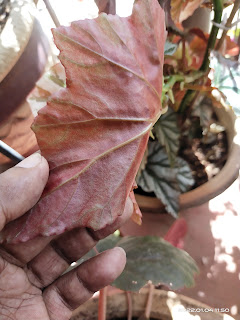INTRODUCTION:
When this particular Cane Begonia was introduced here in the market - it was listed as a Rare Plant Category - it way to say, it came together somewhat with the Maculata "Wightii" (boat) - if you know what I mean.
These were expensive, difficult to manage under the hot & humid climate which didn't help much especially during the transition - many didn't make it during the initial stress, either burned or withered due to the heat and weather which somewhat crashed the need to own one due to the fact these are very much belonged to temperate region plants.
Some did manage to acclimatized but with much care and are in circulation but these do not weather to storm as to say, won't do so well like any other hardy Cane Begonia plants that you can put under rain and sun.
CHARACTERISTICS:
One of the Main features with Cane Begonia 'White Ice' are their spots - the speckles are very much uniform and well "sprayed" if you can say that - the fact is that it does appear to have some resembles with other variety of hybrids like "Mrs Hashimoto"
First thing about Cane Begonia 'White Ice' is the shape of the foliage - the unique "Horned" at the top and the "Tail" at the bottom - giving a nice "Kite" shape in an Angel winged Begonia features - if you were to put two together they may resembles a beautiful pair of wings.
The beauty of this is that these spots can change in their appearance due to the brightness of the light it receives - too shaded then lesser spot and may appear to have a bigger green space in between spots.
And if exposed too much to bright direct hot sun, these leaves can easily get burned and damaged.
Also, unlike Maculata species, these do not have burgundy coloration at the back of the leaves, but a slight red veining in appearance - similar like "Mrs Hashimoto" hybrids.
One of the other matters with the "White Ice" Collection is their sensitivity. There are few series that have been introduced here few years ago but really didn't make itself popular in the Plant Market due to the short lifespan. Reason being - these are too expensive and sensitive plants - many gardeners are not interested in investing something that doesn't last long - these are not terrarium plants either - least to say, not a small plant that you can put in a bottle.
The Ones that were listed in the Ice Category:
Cane Begonia 'White Ice' and Cane Begonia 'Snow Capped"
Others really didn't make it appearance here for the time being or perhaps very much circulated among private collectors exclusively.
PLANT CARE:
Due to the fact this falls into the sensitive plant category - the Plant Care is very much like behaves similar like a "Maculata Wightii" Plant Care.
Extremely slow growing plant - so if you make a small mistake of overwatering, underwatering, too much fertilizer, too much light, too less light.. you know what I mean - anything beyond it's expectation - this plant can easily dies.
The key to success is stable conditions - these types doesn't like any changes - it thrives in constant condition of balance humidity, watering, good medium that ensures well and balance drainage and balanced feeding regime that doesn't overwhelm the plant. Once a proper balance is achieved, it would take about a month for the begonia to establish a good rooting system and once that is set - you can notice a nice growth taking place.
Also do take note - that these do not do so well in long-term conditions when it comes to hot & humid tropical conditions - meaning do not wait until the plant had overgrown and show signs of fatigue and high maturity on the Canes and Stem - this will be of a very low chance for the plant to be viable for propagation - always take note to always keep spare plants when it comes to this particular one as they can suddenly succumb to rot without any warning.
Once rot sets in - it is too late to safe anything as nothing may take root as the plant is contaminated.
The other factor, like most begonias don't do so well is shock.
Shock as change of weather conditions, changes in location - as when it is thriving in a particular spot and suddenly it have be changed and relocated, change in watering and even in change of a different fertilizer - all these can be detrimental to the plant - either it may get into shock or die - or if it survives, it can remain dormant without any growth for months - until stabilized - it won't show any sign of new growth.
However all is not lost,
This particular Cane Begonia 'White Ice' belongs to my friend and she was able to Care & Cultivate this one with utmost care. In a way to say that though the method can be tedious - it may able to grow and thrive in the hot & humid tropical lowland climate zone here in the South East Asia regions.
Do click below for more information on Cane Begonias.
Cane Begonia Care & Cultivation information.




















































